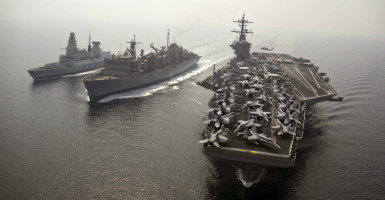The need to modernize the U.S. nuclear arsenal is inevitable, but modernization of Major Force Programs for budget projections needs to come first, said panelists at The Heritage Foundation this month.
The panel explained how informed discussion about the future costs of modernizing the nuclear triad is hampered by the disparity between the different budget projections offered thus far.
That is because the budget categories used haven’t changed in over five decades, said Todd Harrison, director of defense budget analysis at the Center for Strategic and International Studies.
“We haven’t rethought them since the 1960s.”
“As a budgeteer, what I would like to see the Pentagon do is rethink the major force categories. … If you look at Major Force Program 1 for strategic forces, it doesn’t mean nuclear it means long range. That’s what they mean by strategic, and so people often assume that that’s nuclear but it’s not. There’s stuff in there that’s not nuclear related like the B1 bomber. And then there’s a lot of things that are nuclear related that aren’t in there that should be.”
“I think a good thing they could do, not just for nuclear, but for all parts of the force are to just go back and completely rethink the Major Force Program categories and how costs are allocated in those categories. We need a Space 1, we need a cyber category, and we need one that is actually nuclear forces.”
Former Ambassador Eric Edelman, former undersecretary of defense for policy, who served as a member of the Nuclear Weapons Council and the National Defense Panel from 2013 to 2014, voiced a similar idea.
“The most divisive issue, I think among the members was how to think about and what to write about the process for modernization,” said Edelman. “And there were a number of members of the panel, a minority I think, but a vocal and strong minority, who kept invoking the trillion-dollar triad, which was a study done about the costs of modernizing the nuclear force over time.
“I think a majority of members of the panel were not too concerned about a trillion dollars over 30 years because that didn’t seem like actually that much money in a budget of 15 trillion-plus that was likely to eventuate over the 30 years. But there’s also a question in our minds of what really are the costs of the triad, because the numbers that were being thrown around seemed pretty much like a wag rather than something that had been subject to really careful budget scrutiny.”
Imprecise budget projections caused by antiquated categorization and a lack of scrutiny has made it easier for proponents of downsizing the U.S. nuclear triad to claim it is too costly an expense.
“The claim that nuclear weapons are unaffordable has become more common in recent years, at least from my perspective,” said Evan Montgomery, a senior fellow at the Center for Strategic and Budgetary Assessment. “Proponents of reducing U.S. nuclear force structure are increasingly turning to the argument of cost to make their case.”
Harrison refuted such claims.
“Regardless of which of these plans you use [for nuclear budgeting], they all come to about five percent of our defense budget,” said Harrison. “This is half as costly as our health care system.”
A study conducted by Montgomery and Harrison on the budgetary issues of modernizing the triad has brought newfound clarity to the discussion.
“I think it’s injected an element of precision in to this debate that will be salutary for this debate,” said Edelman. “Because I think it establishes that the issue of cost is not one that ought to be driving decisions, that decisions made about the future of the nuclear triad ought to be based on what senior officials conclude is the right nuclear strategy for the United States to have, not some prospective cost that is ‘unaffordable.’”





























